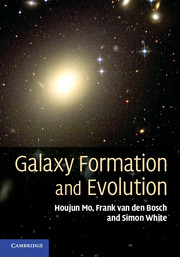Book contents
- Frontmatter
- Contents
- Preface
- 1 Introduction
- 2 Observational Facts
- 3 Cosmological Background
- 4 Cosmological Perturbations
- 5 Gravitational Collapse and Collisionless Dynamics
- 6 Probing the Cosmic Density Field
- 7 Formation and Structure of Dark Matter Halos
- 8 Formation and Evolution of Gaseous Halos
- 9 Star Formation in Galaxies
- 10 Stellar Populations and Chemical Evolution
- 11 Disk Galaxies
- 12 Galaxy Interactions and Transformations
- 13 Elliptical Galaxies
- 14 Active Galaxies
- 15 Statistical Properties of the Galaxy Population
- 16 The Intergalactic Medium
- A Basics of General Relativity
- B Gas and Radiative Processes
- C Numerical Simulations
- D Frequently Used Abbreviations
- E Useful Numbers
- References
- Index
6 - Probing the Cosmic Density Field
Published online by Cambridge University Press: 05 June 2012
- Frontmatter
- Contents
- Preface
- 1 Introduction
- 2 Observational Facts
- 3 Cosmological Background
- 4 Cosmological Perturbations
- 5 Gravitational Collapse and Collisionless Dynamics
- 6 Probing the Cosmic Density Field
- 7 Formation and Structure of Dark Matter Halos
- 8 Formation and Evolution of Gaseous Halos
- 9 Star Formation in Galaxies
- 10 Stellar Populations and Chemical Evolution
- 11 Disk Galaxies
- 12 Galaxy Interactions and Transformations
- 13 Elliptical Galaxies
- 14 Active Galaxies
- 15 Statistical Properties of the Galaxy Population
- 16 The Intergalactic Medium
- A Basics of General Relativity
- B Gas and Radiative Processes
- C Numerical Simulations
- D Frequently Used Abbreviations
- E Useful Numbers
- References
- Index
Summary
In the last two chapters we have described various models for the formation of structures in the cosmic density field. In this chapter we focus on how to test these models with observations. Since the cosmic density field is believed to be a random field generated by some random processes, model tests should be based on statistical properties of the cosmic density field, rather than on matching the predicted and observed fields point by point. Our task is therefore twofold. First, we need to develop statistical measures to characterize the cosmic density field. At any given time, the dynamical state of the cosmic density field is given by the mass distribution in space and the velocities of all mass elements. Thus, statistical characterizations of the cosmic density field are mostly based on the density and velocity fields of matter in the Universe. Such statistical characterizations are described in §§6.1-6.3, and models for the time evolution of some of these statistics are presented in §6.4. The second task is to find suitable observational probes of the cosmic density field. For many years, the distribution of galaxies has been used to infer the mass distribution in the Universe, based on the assumption that there is a simple and well-defined relation between the two. We describe various statistical measures of the galaxy distribution in §6.5.
- Type
- Chapter
- Information
- Galaxy Formation and Evolution , pp. 262 - 318Publisher: Cambridge University PressPrint publication year: 2010



